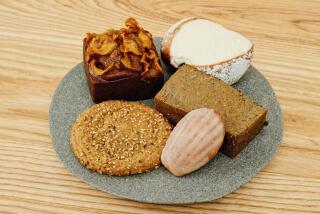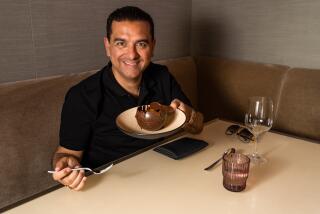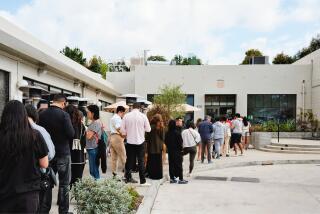Prospects Sweet for Budding Pastry Chefs
HYDE PARK, N.Y. — Americans’ never-ending love of cakes, pies and anything else sweet has created a huge demand in one profession: pastry chefs.
At the Culinary Institute of America, one of the nation’s most prestigious cooking schools, chefs who can turn out exquisite desserts and baked goods have become so sought-after that the institute is doubling the number of entry dates for students interested in making bread and pastry.
“For years, our profession has been in the background. In the middle of the night, the poor baker is in the cellar, baking,” said chef Victor A.L. Gielisse, the associate vice president and dean of culinary baking and pastry studies at the institute, on the Hudson River about 75 miles north of New York City.
That’s all changed now that mainstream diners are becoming more sophisticated. The ubiquity of Martha Stewart and food shows on television has raised diners’ expectations.
“The American public is highly educated about food today,” chef George Higgins said as he showed students how to cut pink marzipan hearts to decorate cakes. “It’s a good time for us, for many culinary programs.”
It’s not about gorging on mass-produced doughnuts. “It’s always the crowning piece for the meal,” Gielisse said of dessert.
Chef En-Ming Hsu, the first graduate of the baking program in 1992, is now the award-winning pastry chef for the Four Seasons in Chicago. She supervises 10 people and oversees all baking for the hotel.
“It’s a madhouse. We’re busy,” she said. The institute’s baking program gave her training in the fundamentals, she said.
She said she fields numerous calls from businesses looking for pastry chefs. “There are a lot of hotels ... looking for a lot of pastry chefs.”
“People are more aware of what pastry chefs can do,” she said.
U.S. Bureau of Labor Statistics data illustrate the demand for chefs who bake: A 16% growth in retail bakeries, a 12% growth in baking manufacturing and a 32% growth in hotels and lodging by 2008 is expected.
The culinary institute has about 2,100 students. Of those, 300 specialize in the baking arts. The school runs throughout the year, allowing students pursuing a bachelor’s degree to finish in 38 months. An associate’s degree takes 21 months.
Tuition ranges from $11,000 to $16,000 a year.
The interest in baked goods marks a new appreciation for the specialty, but consumers aren’t necessarily demanding fancy concoctions. They’re looking for comfort food with excellent ingredients, said chef Thomas Gumpel, an associate dean for baking and pastry arts at the school.
“The consumer is starting to see dessert is part of the meal,” he said.
Higgins said making pastries appeals to his creative side and that he enjoys working with his hands. “It just suited me perfectly.”
And chef Daniel Budd, holding a pan of passion fruit jelly for a class on pectin, put it this way: “I’m the luckiest guy in the world. I get to go to work and make candy.”
Many of the graduates don’t have trouble finding a job.
“It’s an industry that’s clamoring for people,” said Ray Wells, the director of career services at the school, which has a 96% placement rate. Starting salaries as a pastry chef can range from $18,000 to $30,000. An experienced pastry chef can make more than $100,000.
The school has placed chefs--including pastry chefs--in some of the finest restaurants in the country, such as the Ritz Carlton hotels, Equinox in Manchester, Vt., and the Park Avenue Cafe in New York.
And the author of the “Death by Chocolate” cookbooks, Marcel Desaulniers, graduated from the school before there was a specific pastry and baking program.
Student Michelle Hoekstra of Buffalo, Minn., said she loves working with the ingredients.
“I like getting my hands into bread, and I think gluten is really cool,” said Hoekstra, trying a recipe for pound cake using peanut butter as the fat component. She said she wants to travel the world and taste everything she can before settling down and becoming a pastry chef, perhaps opening her own restaurant someday.
The desserts and breads created by the novice bakers at the school are delectable and rich. The goodies are sold in the public cafe and bakery on the campus.
They are also served in the school’s restaurants, and as lunchtime draws near, classes take on the real-life aura of a frantic restaurant kitchen before mealtime.
“You’re providing comfort. You’re nurturing culture,” Gielisse said. “Sharing a meal with people is one of the best things in life.”
More to Read
Eat your way across L.A.
Get our weekly Tasting Notes newsletter for reviews, news and more.
You may occasionally receive promotional content from the Los Angeles Times.







